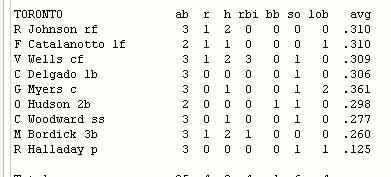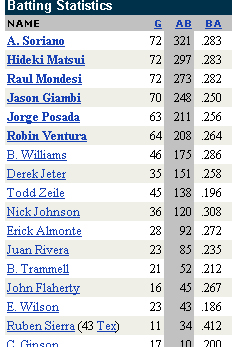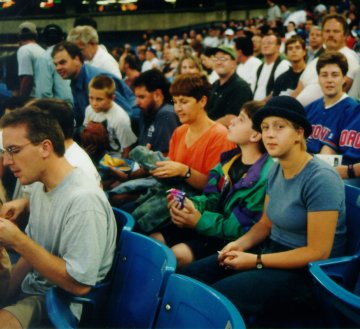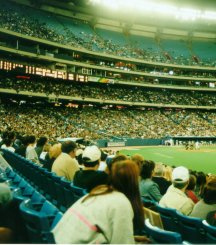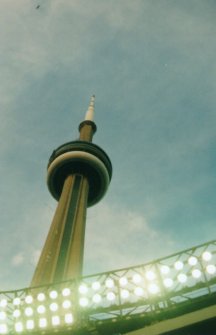The consistent mediocrity of the Toronto Blue Jays is a wonder to behold. We know that Tampa Bay and Baltimore, enjoying a brief surge right now, are going to fall back and end up fifth and sixth. And we know that the Red Sox will dominate the division, and the Yankees are vulnerable. Doesn’t seem to matter: almost every year since their World Series Championship in 1993, the Blue Jays must just enough talent to finish 3rd. Given the annual disappointment with this team, I’m ready to start wishing they would finish last so they could purge themselves of this steady succession of over-rated, underperforming hitters and rebuild.
I had thought this year might be different. They have a lot of young, strong pitching arms, a very good bullpen, and what looked like a reasonably productive offense. But over the last 10 games, the Blue Jays get few men on base and then consistently fail to advance them. Their starting pitching is fine, typically going five or six competitive innings. Then it’s almost as if the failure of the offense to take advantage and produce runs begins to eat away at the pitching staff and their defense collapses.
The two biggest problems were the DH and first base– the two most important positions to the offense, and the only positions in which power numbers obviate the need for any particular defensive skills or speed. Those two positions, occupied by Frank Thomas and Lyle Overbay (until Thomas was released last week), produce virtually nothing for the Blue Jays. If your outfielders and catcher aren’t producing– and, for the Blue Jays, they aren’t– then your DH and your first base should occasionally carry the offense. They didn’t last year, until Frank Thomas got hot– too late– in August (and even then, Overbay continued to struggle), and they’re not doing it this year. Rios showed promise early last year, but his power numbers dropped off significantly, and Wells has been a disappointment since receiving a fat long-term contract. Stairs, who occasionally subs in left field, has probably been their best hitter for the past two years and the good news, I hope, is that he won’t be forced to share as much playing time with Frank Thomas any more. Shannon Stewart won’t help the offense much, but his weak arm in left field is certainly going to hurt the defense.
I’m not a fan of David Eckstein, but it has to be admitted– and this is gruesome– that he has actually been their offensive sparkplug the last week. So how do you know when your offense is in deep trouble? When David Eckstein is your offensive “sparkplug”. Personally, I’d still rather see John McDonald out there every day, and I’ll bet most of the pitching staff would as well. For the record, Eckstein is only batting .245 right now with, of course, no power numbers to speak of. He tends to weasel his way on base, and he steals occasionally, but the steal is over-rated as an offensive tool, just as the double is under-rated.
The Blue Jays get very little power from their catchers, but then, unless you’re the Yankees with Jorge Posada, nobody else does either. Still, it would be helpful if your catcher would drive just a few runs in now and then.
It sounds odd but, given all the observable deficiencies in the Blue Jays offense, I still have trouble seeing why they are so bad lately. Roy Halliday started a game in the Skydome against Texas in which he appeared to be dominant. For five or six innings, he held them off the score sheets. The Blue Jays were facing a mediocre pitcher, Vicente Padilla (WHIP 1.69, batting average against of over .300), but except for the occasional single or walk, couldn’t muster the slightest offense against him. You had Thomas, Wells, Rios, Overbay, Hill, Stewart, all parading through the batter’s box to absolutely no discernable effect. Eckstein got on base a few times– and stayed put.

The Blue Jays, even if they are playing well, are going to have games like this occasionally, in which they simply, inexplicably struggle. Even very good teams will have the odd off night against a weak pitcher. But the Blue Jays do this game in and game out for ten, twelve games in a row. It’s baffling. I resist cheap, abstract generalizations like “they lost their focus” or they don’t have enough “passion”, but if I ever saw a team on the field that no longer cared about results, it was the Blue Jays in the 8th inning on Friday night against Kansas, in which they gave up six runs and the lead after two misplayed balls and a moment of pure indifference (see sidebar). If I had been John Gibbons, I think I might have taken Wells out of the game for an inning, just to send a message. That might have been a mistake– but it would have been very tempting. Do we not have some hungry young players at Triple-AAA who would love a shot at the big leagues and who might actually get angry at themselves for making a stupid mistake, or for failing to drive in an important run?
The truth is that J.P. Ricciardi is probably quite right when he blames himself for the poor offensive production lately. That is, he chooses the players: the players he chose are not doing the job. We love to think a great inspirational club-house speech can rally a team to perform better than they would otherwise, but the truth is that no amount of emotional energy can summon talent where it does not exist. The truth is that the players on the field, Wells, Overbay, Rios, Zaun, Stewart, Hill– may just not be all that good. We hear coy allusions to injuries that some of these players “played through” last year, and the year before, and the year before that, as if these players had some kind of admirable sense of self-sacrifice which allowed the team to benefit from their mediocre performances even while they were injured– enough already. If you can’t play because you’re hurt, say so, and get off the field, and the team can at least face the facts and commit to an alternative plan.
If I were Blue Jays management right now, I might do nothing because Rogers Communications, which owns the team, won’t give me any more money. If there was money, I’d go shopping for a new catcher and first base. Listen– would the Yankees take Vernon Wells and Jeremy Accardo for Jorge Posada?
Low point of the season so far: Friday, April 26. With a 4-2 lead in the 7th inning, A. J. Burnett began to struggle with his control and gave up a single and walk. Scott Downs then came in and elicited a perfect double-play ball which Eckstein booted. Downs failed to get anyone out and the Royals– on a seven game losing skid– scored six runs, high-lighted by the infield defense practically ignoring a playable ground ball between first and second and Wells booting another ball in centre, and Gibbons intentionally walking Pena (.143) to load the bases to get to DeJesus, who is currently hitting .414! (DeJesus, of course, drove in two more runs with a single.) At this point in the game, it honestly looked like the Blue Jays really didn’t care anymore. They fell back to 10-14 on the season, 4.5 games out of first, in last place, after less than a month, while the Yankees are struggling.
Added April 30: The Blue Jays just lost two games in a row to Boston in which their starting pitcher went 8 plus innings without giving up more than a run. Yes, that’s brilliant pitching… and sustained offensive mediocrity. In the 8th inning, the Blue Jays had runners on 2nd and 3rd with nobody out. They got one run out of the deal, to tie the game.

